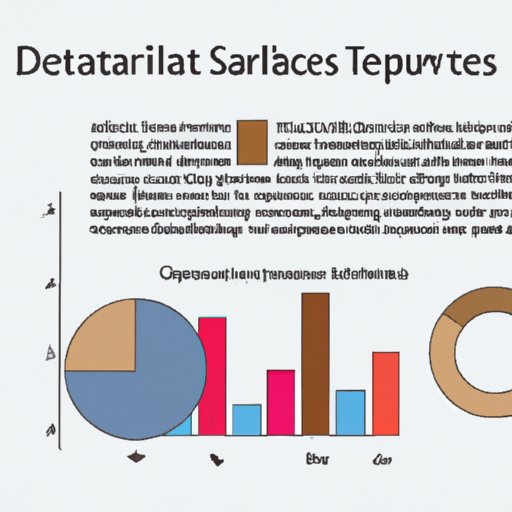Introduction
Qualitative data is a type of data that can provide valuable insights into a variety of scientific fields. This type of data is often used to gain an in-depth understanding of a particular phenomenon or topic. In this article, we will explore what qualitative data is in science, how it can be collected and analyzed, and some examples of how it has been used in the sciences.
Qualitative Data Analysis: What is it and How to Use it?
Qualitative data analysis is an iterative process that involves examining and interpreting data from a range of sources. This type of analysis is typically used to identify patterns and trends in order to gain a better understanding of a given phenomenon. The process usually begins with data collection and then moves on to data coding, which is the process of assigning labels to the data in order to make it easier to analyze. After the data has been coded, the analyst can then use a variety of analytical techniques such as thematic analysis, content analysis, and discourse analysis to interpret the data.
Qualitative Data in the Sciences: Definition and Examples
Qualitative data is a type of data that is non-numerical in nature and is used to gain an in-depth understanding of a particular phenomenon or topic. This type of data can include interviews, surveys, observations, documents, photographs, videos, audio recordings, and other forms of data that can provide insight into a particular issue or topic. For example, interviews can provide valuable information about people’s attitudes and beliefs, while surveys can provide insight into people’s opinions and behaviors. Observations can provide insight into how people interact with their environment, and documents can provide insight into organizational processes.
Qualitative Research in the Sciences: Overview, Benefits, and Challenges
Qualitative research is a type of research method that focuses on understanding a particular phenomenon in its natural context. This type of research is often used to gain an in-depth understanding of a particular issue or topic. Qualitative research can be used to uncover underlying assumptions and beliefs, as well as to uncover new perspectives and insights. Some of the benefits of using qualitative research in the sciences include a greater understanding of complex phenomena, an ability to identify hidden factors, and an ability to uncover unexpected relationships.
However, there are also some challenges associated with using qualitative research in the sciences. These include difficulty in replicating results, difficulty in obtaining reliable data, and potential bias due to researcher subjectivity. Additionally, qualitative research can be time-consuming and expensive due to the need for data collection and analysis.

Qualitative Data Collection in the Sciences: Techniques and Strategies
Qualitative data collection is an important part of any research project. Common data collection techniques used in the sciences include interviews, focus groups, surveys, field notes, document analysis, and observation. Each technique has its own set of advantages and disadvantages, so it is important to select the most appropriate method for the particular project.
In addition to selecting the most appropriate technique, it is also important to develop a strategy for the data collection process. This includes deciding who should be included in the study, when and where data should be collected, and how the data should be recorded and stored. Additionally, it is important to ensure that the data is collected in a way that is ethical and respectful of the participants.

Qualitative Data Analysis in the Sciences: Methodology and Tools
Once the data has been collected, it must be analyzed in order to draw meaningful conclusions. There are a variety of analytical methods that can be used to analyze qualitative data, including thematic analysis, content analysis, discourse analysis, narrative analysis, and grounded theory. It is important to select the most appropriate method for the particular research project in order to ensure that the data is accurately analyzed.
In addition to selecting the most appropriate analytical method, it is also important to have the right tools for analyzing the data. These tools can include software programs such as NVivo, Atlas.ti, or Excel, as well as manual coding methods such as open coding or axial coding. Having the right tools can help to ensure that the data is accurately analyzed and interpreted.

Qualitative Data Analysis in the Sciences: Interpretation and Presentation
Once the data has been analyzed, it must be interpreted in order to draw meaningful conclusions. There are a variety of approaches that can be used to interpret qualitative data, including descriptive approaches, interpretive approaches, and critical approaches. Depending on the particular research project, one or more of these approaches may be used to interpret the data.
Once the data has been interpreted, it must be presented in a clear and concise manner. This can include creating tables and graphs, writing reports, and giving presentations. Additionally, it is important to consider the audience when presenting the data, as different audiences may require different types of presentations.
Conclusion
Qualitative data is a type of data that can provide valuable insights into a variety of scientific fields. This type of data can be collected and analyzed using a variety of techniques and tools, and can be interpreted and presented in a clear and concise manner. By understanding the concept of qualitative data in science and how it can be collected, analyzed, interpreted, and presented, researchers can gain a better understanding of a particular phenomenon or topic.
(Note: Is this article not meeting your expectations? Do you have knowledge or insights to share? Unlock new opportunities and expand your reach by joining our authors team. Click Registration to join us and share your expertise with our readers.)
